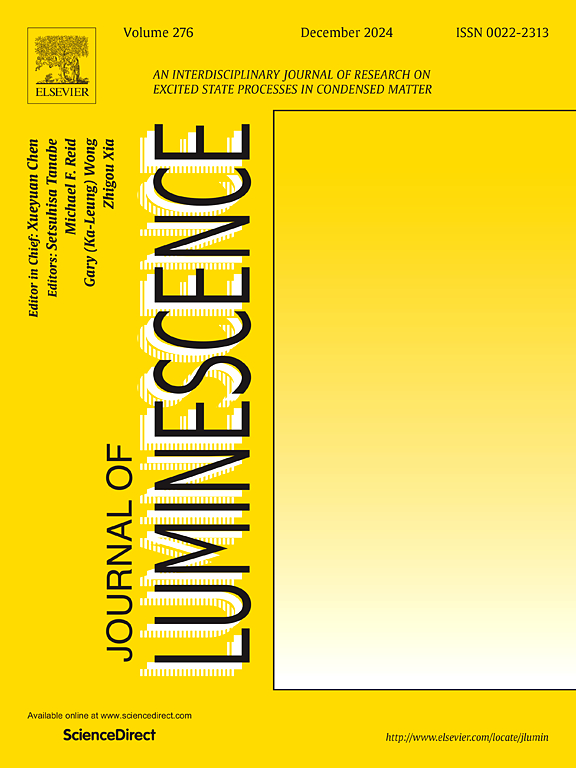Ho3+活化Ca2SnO4荧光粉的双模式发光和异常热猝灭
IF 3.3
3区 物理与天体物理
Q2 OPTICS
引用次数: 0
摘要
本文采用高温固相法合成了Ho3+和Ho3+/Yb3+共掺杂的Ca2SnO4 (CSO)荧光粉。在980 nm激发下,CSO: Ho3+/Yb3+通过双光子UC工艺表现出550 nm的绿色发射(5F4, 5S2→5I8)和650 nm的红色发射(5F5→5I8),发光色度与掺杂浓度无关。在461 nm蓝色激发下,CSO: Ho3+和CSO: Ho3+/Yb3+荧光粉获得了具有异常热猝灭效应的550nm强纯绿色发射。与室温(298 K)相比,CSO: Ho3+和CSO: Ho3+/Yb3+在373 K和348 K下的绿色发射强度分别达到106%和112%,这是由于基体本质缺陷所致。在423 K时,Yb3+掺入CSO: Ho3+进一步提高了荧光强度,从87.7%提高到103.8%。该荧光粉具有UC和DC双模发光和异常热猝灭特性,在绿色发光led中具有应用前景。本文章由计算机程序翻译,如有差异,请以英文原文为准。
Dual mode luminescence and abnormal thermal quenching of Ho3+ activated Ca2SnO4 phosphors
In this work, Ho3+ and Ho3+/Yb3+ co-doped Ca2SnO4 (CSO) phosphors are synthesized using high-temperature solid-state method. Under 980 nm excitation, CSO: Ho3+/Yb3+ exhibits 550 nm green emission (5F4, 5S2 → 5I8) and 650 nm red emission (5F5 → 5I8) via a two-photon UC process, and the luminescence chromaticity is independent of the dopant concentration. Intense pure 550 nm green emission with abnormal thermal quenching effect in CSO: Ho3+ and CSO: Ho3+/Yb3+ phosphors are obtained under 461 nm blue excitation. The green emission intensities of CSO: Ho3+ and CSO: Ho3+/Yb3+ reach 106 % at 373 K and 112 % at 348 K, respectively, in comparison to that at ambient temperature (298 K), which is attributed to matrix based intrinsic defects. The incorporation of Yb3+ in CSO: Ho3+ further enhances the fluorescence intensity from 87.7 % to 103.8 % at 423 K. These phosphors with UC and DC dual-mode luminescence and abnormal thermal quenching behavior have application prospect for green emitting LEDs.
求助全文
通过发布文献求助,成功后即可免费获取论文全文。
去求助
来源期刊

Journal of Luminescence
物理-光学
CiteScore
6.70
自引率
13.90%
发文量
850
审稿时长
3.8 months
期刊介绍:
The purpose of the Journal of Luminescence is to provide a means of communication between scientists in different disciplines who share a common interest in the electronic excited states of molecular, ionic and covalent systems, whether crystalline, amorphous, or liquid.
We invite original papers and reviews on such subjects as: exciton and polariton dynamics, dynamics of localized excited states, energy and charge transport in ordered and disordered systems, radiative and non-radiative recombination, relaxation processes, vibronic interactions in electronic excited states, photochemistry in condensed systems, excited state resonance, double resonance, spin dynamics, selective excitation spectroscopy, hole burning, coherent processes in excited states, (e.g. coherent optical transients, photon echoes, transient gratings), multiphoton processes, optical bistability, photochromism, and new techniques for the study of excited states. This list is not intended to be exhaustive. Papers in the traditional areas of optical spectroscopy (absorption, MCD, luminescence, Raman scattering) are welcome. Papers on applications (phosphors, scintillators, electro- and cathodo-luminescence, radiography, bioimaging, solar energy, energy conversion, etc.) are also welcome if they present results of scientific, rather than only technological interest. However, papers containing purely theoretical results, not related to phenomena in the excited states, as well as papers using luminescence spectroscopy to perform routine analytical chemistry or biochemistry procedures, are outside the scope of the journal. Some exceptions will be possible at the discretion of the editors.
 求助内容:
求助内容: 应助结果提醒方式:
应助结果提醒方式:


